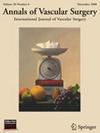Guideline-Adherent Care is Associated with Higher Rates of Symptom Relief in Claudicants with Surgical Intervention
IF 1.6
4区 医学
Q3 PERIPHERAL VASCULAR DISEASE
引用次数: 0
Abstract
Background
Surgical guidelines recommend intervention in claudicants with severe lifestyle limiting symptoms that have failed optimal medical therapy (OMT) and supervised exercise therapy. We investigate the rate of complete guideline-adherent care in claudicants and assess its impact on postsurgical symptom relief.
Methods
A single institution retrospective cohort study was performed on claudicants with an endovascular/open surgical intervention from 2014 to 2023. Guideline adherence was defined as: lifestyle limitation documentation, OMT adherence (composite of single antiplatelet agent, lipid-lowering therapy, smoking cessation), and exercise therapy completion. The primary outcome was symptom relief at 1 year, defined as an improvement in walking distance or impact on activities of daily living. Statistical analysis included independent sample t-tests, Pearson χ2 tests, Kaplan-Meier analysis, and logistic regression modeling.
Results
Of 258 claudicants with surgical intervention, 19% were guideline-adherent. Lifestyle limitation documentation was found in 62.4% of patients, 65.1% were on OMT, and 31% completed exercise therapy. One-year symptom relief was found in 87.8% of guideline-adherent patients, compared to 67.0% of guideline-nonadherent patients (P = 0.01). On multivariable logistic regression analysis, guideline-adherence (odds ratio [OR]: 3.31 [1.30, 8.42], P = 0.01), 5-factor modified frailty index >2 (OR: 0.48 [0.27, 0.87], P < 0.02), and prior peripheral vascular intervention (OR: 0.27 [0.13, 0.59], P < 0.01) were predictors of 1-year symptom relief.
Conclusion
Guideline-directed care in claudicants remains low, despite its association with 1-year symptom relief. There is increasing need for initiatives to qualitatively characterize and improve adherence rates of guideline-directed care in claudicants.
在手术干预的患者中,遵循指南的护理与更高的症状缓解率相关。
目的:外科指南推荐对有严重生活方式限制症状且最佳药物治疗(OMT)和监督运动治疗(SET)失败的患者进行干预。我们调查了患者完全遵循指南护理的比率,并评估其对术后症状缓解的影响。方法:对2014年至2023年接受血管内/开放手术干预的患者进行单机构回顾性队列研究。指南依从性定义为:生活方式限制文件,OMT依从性(单一抗血小板药物,降脂治疗,戒烟的组合)和运动治疗的完成。主要结局是一年后症状缓解,定义为步行距离的改善或对日常生活活动的影响。统计分析包括独立样本t检验、Pearson χ2检验、Kaplan-Meier分析和logistic回归模型。结果:258例手术干预患者中,19%遵循指南。62.4%的患者有生活方式限制记录,65.1%的患者接受OMT治疗,31%的患者完成了运动治疗。在遵循指南的患者中,87.8%的患者在一年内症状缓解,而未遵循指南的患者中,这一比例为67.0% (p = 0.01)。在多变量logistic回归分析中,指南依从性(OR: 3.31 [1.30, 8.42], p = 0.01)、5因素修正的衰弱指数>2 (OR: 0.48 [0.27, 0.87], p < 0.02)和既往外周血管干预(OR: 0.27 [0.13, 0.59], p < 0.01)是1年症状缓解的预测因素。结论:指南指导下的患者护理仍然很低,尽管它与一年的症状缓解有关。有越来越多的需要主动定性表征和提高患者指南指导护理的依从率。
本文章由计算机程序翻译,如有差异,请以英文原文为准。
求助全文
约1分钟内获得全文
求助全文
来源期刊
CiteScore
3.00
自引率
13.30%
发文量
603
审稿时长
50 days
期刊介绍:
Annals of Vascular Surgery, published eight times a year, invites original manuscripts reporting clinical and experimental work in vascular surgery for peer review. Articles may be submitted for the following sections of the journal:
Clinical Research (reports of clinical series, new drug or medical device trials)
Basic Science Research (new investigations, experimental work)
Case Reports (reports on a limited series of patients)
General Reviews (scholarly review of the existing literature on a relevant topic)
Developments in Endovascular and Endoscopic Surgery
Selected Techniques (technical maneuvers)
Historical Notes (interesting vignettes from the early days of vascular surgery)
Editorials/Correspondence

 求助内容:
求助内容: 应助结果提醒方式:
应助结果提醒方式:


